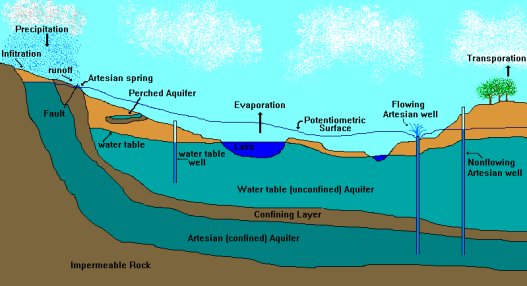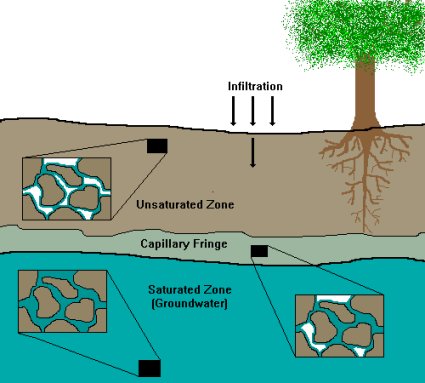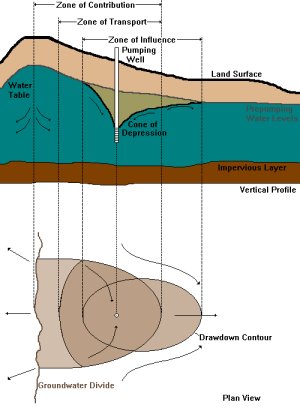Frequently-Asked Questions
-
What is wellhead protection?
Wellhead Protection is a preventative program to protect public water supply systems. The goal is to prevent contaminants from entering public supply wells.
-
What is groundwater?
Groundwater is water occurring in the zone of saturation in an aquifer or soil. Water beneath the surface of the earth which saturates the pores and fractures of sand, gravel, and rock formations.

-
Where does groundwater come from?
Groundwater begins as precipitation that is absorbed into the ground. Much of the precipitation is taken up by plant roots and evapotranspired. What makes it beyond to root zone is pulled down by gravity until it reaches the water table. Below the water table all the pore space in the soil is filled with water. This is the saturated zone.

-
What are the types of contaminants?
There are three basic types of contaminants. They are microorganisms, inorganic chemicals, and organic chemicals.
Microorganism contaminants include bacteria (i.e. E. coli and Salmonella), viruses, protozoa (i.e. Cryptosporidium and Giardia lamblia) and parasites. They are usually just a concern for shallow wells as the soil does a fairly good job of trapping them.
Inorganic chemicals are chemicals such as nitrate, arsenic, and metals. Many of these chemicals are found naturally in the soil and are not in high enough concentrations to cause harm. Public Water Supplies are required to monitor for them. Many land uses can increase their concentrations. For example, applying too much fertilizer can increase the amount of nitrate in the groundwater. Intake of water high in nitrates can cause methemoglobinemia (blue baby syndrome) in infants, which reduces the blood's ability to carry oxygen. If left untreated it can be fatal.
Organic chemicals include pollutants such as fuels, solvents, and pesticides. It only takes a small amount of these chemicals to cause health concerns. These chemicals have a tendency to do one of three things when they come into contact with water. How they react is based on their physical and chemical properties.
- Some of the pollutants dissolve in the water, and are able to travel long distances from their source. They can also be distributed from the top of the aquifer to the bottom. An example of a chemical that dissolves is MTBE (methyl tertiary butyl ether), a commonly used fuel additive.
- The second type floats on the surface of the water because they are lighter than water. An example of this type of chemical would be gasoline.
- The third type sinks down to the bottom of the aquifer and flows along the bottom of the aquifer because they are heavier than water. These dense, nonaqueous phase pollutants (DNAPLs) are especially difficult to remove.
-
How can groundwater be contaminated?
As groundwater infiltrates the soil, it can pick up contaminants from the surface of the ground or from the surrounding soil. The water may dissolve the contaminant or just carry it in to the aquifer. Some contaminants can be transported great distances from their source. Groundwater travels very slowly; therefore, little dilution or dispersion of the contaminant usually occurs. The contaminant forms a concentrated plume that follows the groundwater flow path.

-
What are the potential sources of contamination?
There are many different potential sources of contamination. Anywhere that has or uses chemicals can be considered a potential source. Some of the commonly known sources of contaminants are underground storage tanks (USTs), septic tanks, surface impoundments, agricultural activities, landfills, industries, drycleaners, abandoned wells, highway de-icing, accidents, and illegal dumping.
-
What is a Wellhead Protection Plan?
A Wellhead Protection Plan is a program written by a local team to protect public water supply systems from potential sources of groundwater contamination. It is done by forming a wellhead protection team to delineate the area that needs protection, taking an inventory of potential sources of contamination, using appropriate management strategies, developing contingency plans, planning for future wells, and involving the public in the development and implementation process. For more information on the process please visit History of WHP.
-
Who is responsible for Wellhead Protection?
Michigan's WHPP is a voluntary program, so it is the community that is responsible for establishing their program. This does not mean that they have to do it all on their own. There are many people and agencies that are more than willing to help communities get their programs started. Many of the communities that already have their WHPP up and running are willing and able to share pointers and helpful tips. Other agencies willing to help are the Michigan Department of Environmental Quality (MDEQ), Michigan Department of Agriculture and Rural Development (MDARD) and MSU.
-
Why do we need a Wellhead Protection Plan?
Every community needs a clean source of drinking water. If your community's source of drinking water is from wells, they need to be protected from contamination. A WHPP is in the best interest of the community because it protects the public health, the environment, and economy. It is an investment in the community.
-
What is the Wellhead Protection Area?
A Wellhead Protection Area (WHPA) is a geographically designated surface and subsurface area surrounding a water well or well field, supplying a Public Water System, through which contaminants are reasonably likely to move toward and reach such water well or well field. This is an area where groundwater protection is emphasized. A WHPA includes at least the delineated capture zone area, but could be influenced by other factors such as existing land use and zoning, site and facility identification and location, political boundaries, natural features, and environmentally sensitive areas.

-
How large is the Wellhead Protection Area?
A WHPA can be many varying sizes depending on a number of factors. Some of these factors include the pumping rate, the surrounding geology and characteristics of the aquifer, and the time of travel for pollutants. Michigan's WHPP requires a 10 year time of travel to insure that if the groundwater were to become contaminated there would be adequate time to devise a plan to deal with the contamination before it reaches the well. WHPAs may extend several thousand feet upgradient of the well to protect it.
-
What can I do?
Groundwater protection begins at home. The way you dispose of the products you use can contribute to the contamination of your community's groundwater. Products like motor oil, pesticides, leftover paints or paint cans, weed killers, household cleaners, flea collars, mothballs, and a number of medicines contain materials that can be harmful to groundwater. The average American gets rid of approximately one pound of this type of waste each year. This may seem inconsequential but it is quite large when you multiply it by the number of people in your community. Here are some tips for wisely managing household hazardous waste:
- Don't dump it on the ground - It can contaminate the soil and leach into the groundwater
- Don't put it in the trash - Community landfills are not equipped to handle hazardous materials.
- Don't pour it down the drain - Septic tanks and waste treatment facilities are not able to treat it and it can interfere with the systems ability to treat human wastes.
- Store chemicals in a safe place - They should be kept away from the elements and out of reach of children and pets.
- Dispose of harmful materials properly - Find out where and how to safely get rid of your household hazardous products. Many communities have household hazardous waste collection days.
- Remember the three R's
- Reduce the amount of chemicals that you use. They are not always necessary to complete a job.
- Reuse materials for other uses. If you bathe your dog in an outside tub, use the water on your lawn.
- Recycle used motor oil, anti freeze, dead batteries, and pesticide containers.
- Whenever possible, substitute a non-hazardous product - Look for "environmentally friendly" products at the store.
- Buy only as much as you need - Larger quantities may be less expensive, but cause a problem when trying to dispose of them safely.
- Keep water conservation in mind with all your daily activities - By reducing the total quantity withdrawn, the rate of withdrawal and the spread of any contaminant can be reduced. For more information on what you can do to conserve water, visit the Environmental Protections Agency’s Groundwater Primer's Water Conservation page.
If you think you cannot have a positive influence on the environment, you need to reconsider. The right choices can reduce waste, save money, maximize resources, and protect the environment. The choices you make can and do make a big difference.

